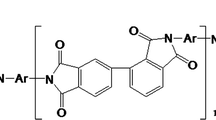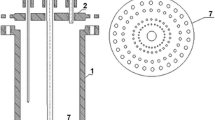Abstract
Thermal effect in absorbing composite is concerned gradually due to electromagnetic environment tends to high power, high frequency and wide bandwidth. Microstructure characteristics and some basic material properties of carbonyl iron powder/silicone rubber (CIP/SR) are obtained by experiments method. Complex permittivity and permeability of CIP/SR composite as an absorbing material is measured by the vector network analyzer. CIP/SR composite with 78 wt% particles filling exhibits excellent absorption performance in C and X band. A numerical model coupled with electromagnetic wave, heat transfer and mechanics theory is presented to study the thermal effect and mechanical damage of absorbing composite under microwave radiation. Microwave heating and attenuation mechanism of CIP/SR composite are discussed. Electric field, temperature, stress and deformation in CIP/SR composite are quantitatively characterized. The results indicate temperature distribution relates to electric polarization and hysteresis loss. Temperature of CIP/SR composite increases by 36 °C as microwave radiation lasts 2 s at 9.37 GHz. Thermal expansion and stress concentration will be aggravated as frequency increases.
















Similar content being viewed by others
References
Wilson C (2008) High altitude electromagnetic pulse and high power microwave devices: threat assessments, Congressional Research Service. https://www.wired.com/images_blogs/dangerroom/files/Ebomb.pdf
Loharkar PK, Ingle A, Jhavar S (2019) Parametric review of microwave-based materials processing and its applications. J Mater Res Technol 8(3):3306–3326. https://doi.org/10.1016/j.jmrt.2019.04.004
Wanasinghe D, Aslani F (2019) A review on recent advancement of electromagnetic interference shielding novel metallic materials and processes. Compos Part B-Eng 176:107207. https://doi.org/10.1016/j.compositesb.2019.107207
Munalli D, Dimitrakis G, Chronopoulos D, Greedy S, Long A (2019) Electromagnetic shielding effectiveness of carbon fibre reinforced composites. Compos Part B-Eng 173:106906. https://doi.org/10.1016/j.compositesb.2019.106906
Chung DDL (2001) Electromagnetic interference shielding effectiveness of carbon materials. Carbon 39(2):279–285. https://doi.org/10.1016/S0008-6223(00)00184-6
Lou CW, Huang CL, Pan YJ, Lin ZI, Song XM, Lin JH (2016) Crystallization, mechanical, and electromagnetic properties of conductive polypropylene/SEBS composites. J Polym Res 23(5):84. https://doi.org/10.1007/s10965-016-0979-4
Sahoo BP, Naskar K, Tripathy DK (2012) Conductive carbon black-filled ethylene acrylic elastomer vulcanizates: physico-mechanical, thermal, and electrical properties. J Mater Sci 47(5):2421–2433. https://doi.org/10.1007/s10853-011-6065-8
Wang C, Murugadoss V, Kong J, He Z, Mai X, Shao Q (2018) Overview of carbon nanostructures and nanocomposites for electromagnetic wave shielding. Carbon 140:696–733. https://doi.org/10.1016/j.carbon.2018.09.006
Barsukov V, Senyk I, Kryukova O, Butenko O (2018) Composite carbon-polymer materials for electromagnetic radiation shielding. Mater Today Proc 5(8):15909–15914. https://doi.org/10.1016/j.matpr.2018.06.063
Gupta S, Tai NH (2019) Carbon materials and their composites for electromagnetic interference shielding effectiveness in X-band. Carbon 152:159–187. https://doi.org/10.1016/j.carbon.2019.06.002
Li Z, Haigh A, Soutis C, Gibson A (2019) X-band microwave characterisation and analysis of carbon fibre-reinforced polymer composites. Compos Struct 208:224–232. https://doi.org/10.1016/j.compstruct.2018.09.099
Sankaran S, Deshmukh K, Ahamed MB, Pasha SK (2018) Recent advances in electromagnetic interference shielding properties of metal and carbon filler reinforced flexible polymer composites: a review. Compos Part A-Appl S 114:49–71. https://doi.org/10.1016/j.compositesa.2018.08.006
Choy TC (2015) Effective medium theory: principles and applications. Oxford University Press, UK
Wu LZ, Ding J, Jiang HB, Chen LF, Ong CK (2005) Particle size influence to the microwave properties of iron based magnetic particulate composites. J Mater Res Technol 285(1–2):233–239. https://doi.org/10.1016/j.jmmm.2004.07.045
Fu SY, Feng XQ, Lauke B, Mai YW (2008) Effects of particle size, particle/matrix interface adhesion and particle loading on mechanical properties of particulate–polymer composites. Compos Part B-Eng 39(6):933–961. https://doi.org/10.1016/j.compositesb.2008.01.002
Liu X, Wu Y, Zhang Z (2010) Theoretical study of the interface effect on the electromagnetic wave absorbing characteristics. Phys B 405(20):4393–4396. https://doi.org/10.1016/j.physb.2010.08.002
Quan B, Liang X, Ji G, Cheng Y, Liu W, Ma J, Xu G (2017) Dielectric polarization in electromagnetic wave absorption: review and perspective. J Alloy Compd 728:1065–1075. https://doi.org/10.1016/j.jallcom.2017.09.082
Wu N, Liu C, Xu D, Liu J, Liu W, Shao Q, Guo Z (2018) Enhanced electromagnetic wave absorption of three-dimensional porous fe3o4/c composite flowers. ACS Sustain Chem Eng 6(9):12471–12480. https://doi.org/10.1021/acssuschemeng.8b03097
Adebayo LL, Soleimani H, Yahya N, Abbas Z, Wahaab FA, Ridwan AT, Ali H (2019) Recent advances in the development OF Fe3O4-BASED microwave absorbing materials. Ceram Int 46(2):1249–1268. https://doi.org/10.1016/j.ceramint.2019.09.209
Sui M, Lü X, Xie A, Xu W, Rong X, Wu G (2015) The synthesis of three-dimensional (3D) polydopamine-functioned carbonyl iron powder@polypyrrole (CIP@PPy) aerogel composites for excellent microwave absorption. Synthetic Met 210:156–164. https://doi.org/10.1016/j.synthmet.2015.09.025
Yang RB, Liang WF (2011) Microwave properties of high-aspect-ratio carbonyl iron/epoxy absorbers. J Appl Phys 109(7):07A311. https://doi.org/10.1063/1.3536340
Xu Y, Yuan L, Liang Z, Wang X, Li X (2017) A wide frequency absorbing material added CIPs using the fuse deposition modeling. J Alloy Compd 704:593–598. https://doi.org/10.1016/j.jallcom.2017.02.068
Cao XG, Ren H, Zhang HY (2015) Preparation and microwave shielding property of silver-coated carbonyl iron powder. J Alloy Compd 631:133–137. https://doi.org/10.1016/j.jallcom.2015.01.103
Khani O, Shoushtari MZ, Ackland K, Stamenov P (2017) The structural, magnetic and microwave properties of spherical and flake shaped carbonyl iron particles as thin multilayer microwave absorbers. J Magn Magn Mater 428:28–35. https://doi.org/10.1016/j.jmmm.2016.12.010
Min D, Zhou W, Qing Y, Fa L, Zhu D (2017) Greatly enhanced microwave absorption properties of highly oriented flake carbonyl iron/epoxy resin composites under applied magnetic field. J Mater Sci 52(4):2373–2383. https://doi.org/10.1007/s10853-016-0532-1
Duan Y, Li G, Liu L, Liu S (2010) Electromagnetic properties of carbonyl iron and their microwave absorbing characterization as filler in silicone rubber. B Mater Sci 33(5):633–636. https://doi.org/10.1007/s12034-010-0096-7
Guo X, Yao Z, Lin H, Zhou J, Zuo Y, Xu X (2019) Epoxy resin addition on the microstructure, thermal stability and microwave absorption properties of core-shell carbonyl iron@epoxy composites. J Magn Magn Mater 485:244–250. https://doi.org/10.1016/j.jmmm.2019.04.059
Qi Z, Chunbo L, Zhuang W, Yang Y, Zhiyong X, Haikun Z, Chudong C (2019) Preparation of rGO/PVA/CIP composites and their microwave absorption properties. J Magn Magn Mater 479:337–343. https://doi.org/10.1016/j.jmmm.2018.11.129
Li J, Feng WJ, Wang JS, Zhao X, Zheng WQ (2015) Impact of silica-coating on the microwave absorption properties of carbonyl iron powder. J Magn Magn Mater 393:82–87. https://doi.org/10.1016/j.jmmm.2015.05.049
Jeon S, Kim J, Kim KH (2019) Microwave absorption properties of graphene oxide capsulated carbonyl iron particles. Appl Surf Sci 75:1065–1069. https://doi.org/10.1016/j.apsusc.2019.01.017
Qing Y, Zhou W, Luo F, Zhu D (2009) Microwave-absorbing and mechanical properties of carbonyl-iron/epoxy-silicone resin coatings. J Magn Magn Mater 321(1):25–28. https://doi.org/10.1016/j.jmmm.2008.07.011
Xu X, Zhang B, Xing L, Liu K, Bai M, Liu D (2018) Characterization and analysis of the thermal damages of aramid/epoxy composite laminates induced by the dielectric heating effect of microwaves. Compos Struct 200:371–379. https://doi.org/10.1016/j.compstruct.2018.05.092
Li Y, Hang X, Li N, Hao X (2016) A temperature distribution prediction model of carbon fiber reinforced composites during microwave cure. J Mater Process Tech 230:280–287. https://doi.org/10.1016/j.jmatprotec.2015.12.001
Li J, Kaunda RB, Arora S, Hartlieb P, Nelson PP (2019) Fully-coupled simulations of thermally-induced cracking in pegmatite due to microwave irradiation. J Rock Mech Geotech Eng 11(2):242–250. https://doi.org/10.1016/j.jrmge.2018.12.007
Kwon SK, Ahn JM, Kim GH, Chun CH, Hwang JS, Lee JH (2002) Microwave absorbing properties of carbon black/silicone rubber blend. Polym Eng Sci 42(11):2165–2171. https://doi.org/10.1002/pen.11106
Mabhouti K, Karamirad M, Norouzzadeh P, Golzan MM, Naderai R (2020) Measurement of electric and magnetic properties of ZnO nanoparticles in the X-Band using Nicolson–Ross–Weir analysis. J Electron Mater 2020:1–9. https://doi.org/10.1007/s11664-020-08071-4
Meshram MR, Agrawal NK, Sinha B, Misra PS (2004) Characterization of M-type barium hexagonal ferrite-based wide band microwave absorber. J Magn Magn Mater 271(2–3):207–214. https://doi.org/10.1016/j.jmmm.2003.09.045
Müller C (2013) Foundations of the mathematical theory of electromagnetic waves[M]. Springer, Berlin
Kalluri DK (2011) Electromagnetic waves, materials, and computation with MATLAB[M]. CRC Press, US
Legras B, Polaert I, Thomas M, Estel L (2013) About using microwave irradiation in competitive adsorption processes. Appl Therm Eng 57(1–2):164–171. https://doi.org/10.1016/j.applthermaleng.2012.03.034
Manière C, Zahrah T, Olevsky EA (2017) Fully coupled electromagnetic-thermal-mechanical comparative simulation of direct vs hybrid microwave sintering of 3Y-ZrO2. J Am Ceram Soc 100(6):2439–2450. https://doi.org/10.1111/jace.14762
Nigar H, Sturm GSJ, Garcia-Baños B et al (2019) Numerical analysis of microwave heating cavity: combining electromagnetic energy, heat transfer and fluid dynamics for a NaY zeolite fixed-bed. Appl Therm Eng 155:226–238. https://doi.org/10.1016/j.applthermaleng.2019.03.117
Loomis E, Greenfield SR, Luo SN et al (2009) The dynamics of thermal expansion in single crystal beryllium from nanosecond X-ray irradiation. Fusion Sci Technol 55(2):152–162. https://doi.org/10.13182/FST09-A4068
Milligan TA (2005) Modern antenna design. Wiley, New York
Daniyan OL, Opara FE, Okere BI et al (2014) Horn antenna design: the concepts and considerations. Int J Emerg Technol Adv Eng 4(5):706–708
Acknowledgements
This study is supported by the National Natural Science Foundation of China (No: 51875463), and the Research Funds of Shanxi Key Laboratory of Electromagnetic Protection Material and Technology (No: 33ZD1807KF001C).
Author information
Authors and Affiliations
Corresponding author
Additional information
Handling Editor: Yaroslava Yingling.
Publisher's Note
Springer Nature remains neutral with regard to jurisdictional claims in published maps and institutional affiliations.
Rights and permissions
About this article
Cite this article
Ma, X.T., Jiang, Z.P., Wang, F.S. et al. Numerical study of thermal effect in silicone rubber filled with carbonyl iron powder under microwave radiation. J Mater Sci 56, 10264–10281 (2021). https://doi.org/10.1007/s10853-021-05956-5
Received:
Accepted:
Published:
Issue Date:
DOI: https://doi.org/10.1007/s10853-021-05956-5




